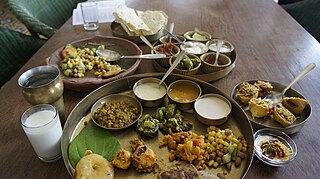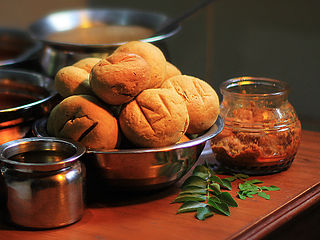
Punjabi cuisine is a culinary style originating in the Punjab, a region in the northern part of South Asia, which is now divided in an Indian part to the east and a Pakistani part to the west. This cuisine has a rich tradition of many distinct and local ways of cooking.

Raita is a side dish in Indian cuisine made of dahi together with raw or cooked vegetables, fruit, or in the case of boondi raita, with fried droplets of batter made from besan.

A fritter is a portion of meat, seafood, fruit, vegetables, or other ingredients which have been battered or breaded, or just a portion of dough without further ingredients, that is deep-fried. Fritters are prepared in both sweet and savory varieties.

Chaat, or chāt is a family of savoury snacks that originated in India, typically served as an hors d'oeuvre or at roadside tracks from stalls or food carts across South Asia in India, Pakistan, Nepal and Bangladesh. With its origins in Uttar Pradesh, India, chaat has become immensely popular in the rest of South Asia.

Rajasthani cuisine is the cuisine of the Rajasthan state in North West India. It was influenced by various factors like the warlike lifestyles of its inhabitants, the availability of ingredients in an arid region and by Hindu temple traditions of sampradayas like Pushtimarg and Ramanandi. Food that could last for several days and could be eaten without heating was preferred. Scarcity of water and fresh green vegetables have all had their effect on the cooking. Signature Rajasthani dishes include Dal Baati Churma, Panchratna Dal, Papad ro Saag, Ker Sangri, Gatte ro Saag. It is also known for its snacks like Bikaneri bhujia, Mirchi bada and Kanda kachauri. Other famous dishes include Dal Baati, malaidar special lassi (lassi) and Lashun ki chutney, Mawa lassi from Jodhpur, Alwar ka mawa, Malpauas from Pushkar and rasgulla from Bikaner, "paniya"and "gheriya" from Mewar. Originating for the Marwar region of the state is the concept Marwari Bhojnalaya, or vegetarian restaurants, today found in many parts of India, which offer vegetarian food of the Marwari people. The history also has its effect on the diet as the Rajputs preferred majorly a non-vegetarian diet while the Brahmins, Jains, Bishnois and others preferred a vegetarian diet. So, the state has a myriad of both types of delicacies.

Curd rice, also called yogurt rice, is a dish originating from India. The word "curd" in Indian English refers to unsweetened probiotic yogurt. It is most popular in the South Indian states of Tamil Nadu, Kerala, Karnataka, Telangana and Andhra Pradesh; and also in West Indian states of Rajasthan, Gujarat and Maharashtra.
Maharashtrian or Marathicuisine is the cuisine of the Marathi people from the Indian state of Maharashtra. It has distinctive attributes, while sharing much with other Indian cuisines. Traditionally, Maharashtrians have considered their food to be more austere than others. The best quality food is available in the nashik district which include their world famous Misal.

Gujarati cuisine is the cuisine of the Indian state of Gujarat. The typical Gujarati thali consists of rotli, dal or curry, rice, and shaak. The thali will also include preparations made from pulses or whole beans such as moong, black eyed beans etc., a snack item (farsaan) like dhokla, pathra, samosa, fafda, etc. and a sweet (mishthaan) like mohanthal, jalebi, sevaiya etc.

Sindhi cuisine refers to the distinct native cuisine of the Sindhi people from Sindh, Pakistan. Sindhi cuisine has been influenced by Central Asian, Iranian, Mughal food traditions. It is mostly a non-vegetarian cuisine, with even Sindhi Hindus widely accepting of meat consumption. The daily food in most Sindhi households consists of wheat-based flat-bread (Mani) or rice accompanied by two dishes, one gravy and one dry with curd, papad or pickle. Freshwater fish and a wide variety of vegetables are usually used in Sindhi cuisine. Restaurants specializing in Sindhi cuisine are rare, although it is found at truck stops in rural areas of Sindh province, and in a few restaurants in urban Sindh.

Undhiyu is a Gujarati mixed vegetable dish that is a regional specialty of Surat, Gujarat, India. The name of this dish comes from the Gujarati word "undhu", which translates to upside down, since the dish is traditionally cooked upside down underground in earthen pots, termed "matlu", which are fired from above.
Bhojpuri cuisine is a style of food preparation common among the Bhojpuri people of Bihar, Jharkhand and eastern Uttar Pradesh in India, and also the Terai region of Nepal. Bhojpuri foods are mostly mild and tend to be less hot in terms of spices used. The cuisine consists of both vegetable and meat dishes.

Batata vada is a popular vegetarian fast food dish from the Indian state of Maharashtra. The dish consists of a mashed potato patty coated with chickpea flour, which is then deep-fried and served hot with chutney. The vada is typically around two or three inches in diameter. Across different regions of India, this dish is also known as aloo bonda, aloo vada, batata bonda, potato bonda and potato vada.

Kadhi chawal is a popular dish originating from India. Kadhi is prepared by mixing Curd, Besan and different spices. It is served with boiled rice and is very popular in Northern and Western states of India. It usually has a thick consistency and contains fritters (Pakora). Kadhi in Gujarat & Maharashtra is savoury & sometimes does not have any fritters. Fritters for Kadhi also have several varieties, they are prepared with onions, potato, spinach, etc.

Gujarati kadhi is a Gujarati version of kadhi. It is a very popular Gujarati dish made from buttermilk or dahi (yogurt) and gram flour. Kadhi is an essential part of Gujarati cuisine.

Besan or gram flour is a pulse flour made from chana dal or chickpea flour or brown/kaala chana, a chickpea. It is a staple ingredient in the cuisines of the Indian subcontinent, including Indian, Bangladeshi, Burmese, Nepali, Pakistani, Sri Lankan and Caribbean cuisines.

Daal Baati is an Indian dish of daal (lentils) and baati. It is popular in Rajasthan, Madhya Pradesh, Maharashtra's Khandesh and Vidarbha region, Gujarat, and Uttar Pradesh.

Thepla is a soft Indian flatbread typical of Gujarati cuisine While extremely popular across Gujarat, it is especially common amongst the Jain community.

















